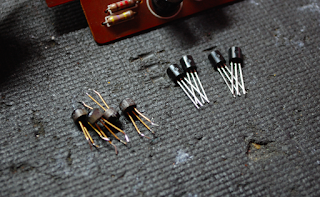Yamaha C-4 and M-2
Today were showcasing a customers two Yamaha’s…the M-2 Power Amplifier and C-4 Pre-Amplifier. The M-2 I hold as one of my personal top favorite amplifiers…featuring incredible build quality and performance you don’t see under $5K typically. The C-4 is a perfectly matching pre-amplifier, with specs to match and beat most pre-amplifiers on the market…and incredibly linear response output!
Yamaha C-4 Pre-Amplifier
The C-4, released from 1979 to 1981 was Yamaha’s upgraded version of the C-1/C2 pre-amplifiers with cartridge loading features. The C-2 employs a robust dual FET RIAA amplifier stage, quality independent headphone amplifier, line level output with incredible S/N, frequency response and total harmonic distortion levels.
NA07153 PS
The C-4 uses a dual bridge rectifier array for the 12 and 45-/+ rail sources, each were replaced with a ultra-fast, soft recovery axial Vishay Diode arrays. The initial filtering stage capacitors were replaced with a high temp (105C) low impedance Nichicon PW type with some capacitor values increased for better filter and all operating voltages increased. Associated regulators were all replaced with a robust TO-220 On-Semi device with synthetic Wakefield compound applied and remounted.
Flat Amp Stage/HP
The line stage amplifiers are separated into several gain/application stages across the main PCB. The various differential stages were Beta matched and replaced with low noise T)-92 Fairchild devices and TO-126 devices for better dissipation due to the high heat environment of the C-4. The Yamaha branded film capacitors were all replaced with high grade MKP Solen polypropylene film capacitors and WIMA polypropylene films. Nichicon Audio grade KT and Muse BP capacitors were installed with an increase in operating voltages.
The Headphone amplifier is its own independent stage capable of driving various loads (though watch out more heat!) The initial differentials were matched and replaced with low noise modern TO-92 Fairchild devices. The VD diodes were replaced with modern 4148 Vishay axial general type. Electrolytic’s were replaced with Audio grade KT and low impedance Nichicon PW’s with an increase in operating voltages.
RIAA EQ NA07149
The C-4 allows for both MM and with the new cartridge loading feature an easily integrated MC amplifiers. With a dual FET differential and loading switch the RIAA is incredibly accurate to the standards at the time and a impressive dynamic margin of 285mV (kHz .01%)
The house branded films were replaced with a high grade MKP Solen polypropylene film capacitor and polypropylene WIMA film capacitors. The electrolytic were replaced with Vp and KT audio grade Nichicon capacitors with an increase in operating voltages.
Hardware
Like most in this series and as discussed below, the 14V lamps tend to fail quickly in these Yamaha’s, all the original lamps are replaced with a long rated LED equivalent…also no more hot buttons ;)
Audio Notizen
Yamaha M-2 Power Amplifier
Produced from 1979 to 1982 the M-2 was rated at a minimal of 240W at an impressive 0.004%THD (8ohm) the M-2 is a DC array with a OCL /triple push pull output complimentary stage.
Pre-Driver & -/+ 80V Supply NA07311
One of the unique features of Yamaha M-2 is the driver design. The Pre-Driver stage was separated from the final driver stage utilizing a different PCB footprint. The Pre-Driver is mounted with a divider shield to the NA07314 assembly for extra noise reduction and disperse interference potential. This stage also helps regulated the -/+80V source for the amplifiers. The VAS stage below is a tiered cascade circuit employing a Dual FET input and a cascade bootstrap circuit, current mirror and PP output.
All of the original Yamaha branded house capacitors were replaced with a high grade MKP Solen Polypropylene film capacitors with .1MFD WIMA polypropylene bypass capacitors. Nichicon PW and High temp (105C) electrolytic capacitors with an increase in operating voltages were installed replacing the original worn out electrolytic. Additional new .1MFD WIMA high grade polypropylene were installed as well. The CD type diodes were all replaced with tied general 4148 axial Vishay diodes. Several of the heat prone 33K resistors were replaced with a 1/2Watt Carbon Film type for better dissipation.
Differential pairs (including current mirror) were matched and installed with low noise modern TO-92 Fairchild devices. Both TO-220 pre-Drivers were replaced with modern, heavy duty TO-220 Fairchild devices thermally coupled with new performance synthetic Wakefield compound. New precision Bourns -/+ Voltage adjustment potentiometers were installed.
BEFORE
AFTER
Driver NA07314
The final driver assembly is mounted parallel, and under the Pre-Driver assembly above. Mounted with heavy copper busses and even TO-3 copper mounting hardware, the TO-3 output banks utilize a heavy powder coated cage as well. The Emitter resistors are fixed via heavy solder mask to the TO-3 mounts using heavy duty sub-chassis mount type wire-wounds. coupled to the above VAS stage the driver uses a three stage emitter output (OCL SEPP) with a high bandwidth output device stage.
New high grade MKP Solen polypropylene film capacitors were installed as well as high grade WIMA polypropylene films. Capacitors were replaced with high temp (105C) Nichicon PW low impedance type with an increase in operating voltages. The Bias adjustment was replaced with a precision Bourns potentiometer. Constant current loads were replaced with modern, reliable TO-126 Fairchild devices.
BEFORE
AFTER
The Outputs were removed, each beta tested and new performance synthetic Wakefield compound applied and remounted.
New 22,000/100V Computer Grade, high quality Nippon Filter Capacitors were installed.
Hardware Upgrades
New LED’s were installed for the original lamps, the originals being 14V small wheat type often burn out as the voltage application is far too high for any decent life span.
New high quality 5-Way Insulated W/ Gold Plated Binding posts were installed replacing the original cumbersome and frail plastic binding posts.
BEFORE
AFTER
Audio Notizen











































































